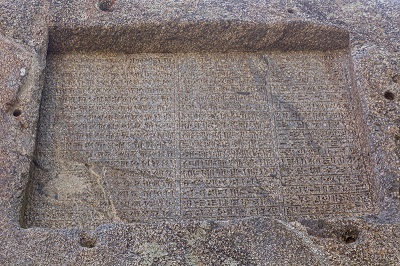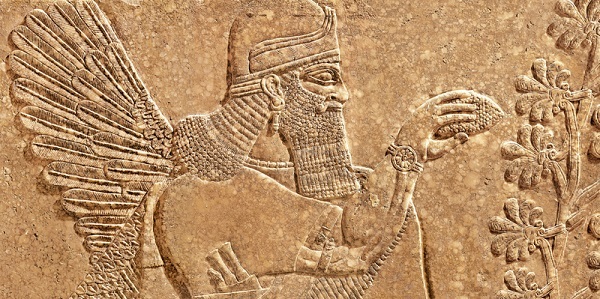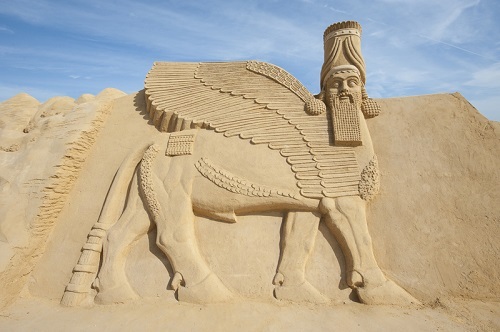

Mesopotamian art during the Akkadian and Neo-Sumerian periods refers to the art and architecture produced in ancient Mesopotamia, which corresponds to modern-day Iraq, Kuwait, eastern Syria, southeastern Turkey, and southwestern Iran. During the Akkadian dynasty (c. 2334-2279 BCE), art and architecture flourished under the rule of Sargon of Akkad and his successors, who commissioned large-scale public works and monumental architecture.
The art of this period is characterized by a blend of Sumerian and Akkadian styles and iconography. On the other hand, during the Neo-Sumerian period (c. 2112-2004 BCE) after the fall of the Akkadian Empire, art and culture saw a resurgence of Sumerian art and culture and the art of this period is characterized by a return to earlier Sumerian styles and iconography.

Ancient Elamite cuneiform script
Ganjnameh cuneiform inscriptions near Hamadan, Iran
Primarily focused on relief sculpture and large-scale architectural decoration, which were commonly found on palace walls, temple walls, and in public spaces.
Incorporated elements of Sumerian and Akkadian mythology and symbolism, such as gods, goddesses, and mythical creatures, which were often depicted in a highly stylized and symbolic manner.
Used a wide range of materials, including stone, metal, and various types of ceramics, with the most common material being clay.
Characterized by highly stylized figures, with an emphasis on symmetry and geometric shapes, which were often used to create a sense of order and harmony.
High level of craftsmanship and attention to detail is evident in surviving works of art, which were created with great care and precision.
The Mesopotamian art style is known for its use of repetition, symmetry, and hierarchy in composition, which creates a sense of order and balance.
The use of color was also an important aspect of Mesopotamian art, with many surviving works being brightly colored and decorated with intricate patterns and designs.
The Mesopotamian art also reflected the society's social hierarchy, with the king and god's depiction in a larger size than the common people.
The Mesopotamian art had a strong connection to their religion and ritual, many of the artworks were used in religious ceremonies and rituals.

Sumerian wall relief of winged genius from Mesopotamia
The Akkadian dynasty (c. 2334-2279 BCE) saw a flourishing of Mesopotamian art and architecture during the reign of Sargon of Akkad.
Sargon built a new capital, Akkad, and commissioned large-scale public works and monumental architecture, such as palaces, temples, and city walls, which were adorned with relief sculptures and other forms of decorative art.
Art of this period is characterized by a blend of Sumerian and Akkadian styles and iconography, with the Akkadian style being more robust and powerful, and the Sumerian style being more refined and delicate.
The Akkadian period also saw the development of glyptic art, including cylinder seals and stamp seals, which were used for identification and record-keeping. These seals were also used for religious, magical and administrative purposes.
The Akkadian Empire's art style is considered to be the first empire style in the world, as it spread throughout Mesopotamia and other parts of the ancient Near East during the reign of Sargon and his successors.
The Akkadian artworks were created with a great level of technical skill and artistic ability, which is evident in the intricate details and realistic portrayals of the figures.
The Akkadian artworks were also influenced by the empire's military conquests, and the depiction of military campaigns and battles are seen on the reliefs and seals.
The Neo-Sumerian period (c. 2112-2004 BCE) saw a resurgence of Sumerian art and culture after the fall of the Akkadian Empire.
Art of this period is characterized by a return to earlier Sumerian styles and iconography, with a focus on traditional Mesopotamian motifs and symbols.
The Neo-Sumerian period also saw the continued use of cylinder seals and stamp seals for identification and record-keeping. These seals were also used for religious, magical and administrative purpose.
The Neo-Sumerian artworks were created with a great level of technical skill and artistic ability, which is evident in the intricate details and realistic portrayals of the figures.
The Neo-Sumerian art also reflected the society's social hierarchy, with the king's depiction in a larger size than the common people.
The Neo-Sumerian art had a strong connection to their religion and ritual, many of the artworks were used in religious ceremonies and rituals.
The Neo-Sumerian period also saw the development of architectural achievements, such as the complex at Eshnunna, which is known for its monumental gates, walls, and ziggurat.
In conclusion, from the earliest days of Sumerian civilization to the Akkadian and Neo-Sumerian periods, Mesopotamian art has reflected the cultural, religious, and political milieu of the time. The art is characterized by the use of relief sculpture and large-scale architectural decoration, and incorporates elements of Sumerian and Akkadian mythology and symbolism.
The Mesopotamian art style is also known for its use of stylized figures, symmetry and geometric shapes, and its high level of craftsmanship. The art of this region is not only an important historical record but also a testament to the creativity and skill of the ancient Mesopotamian people.

Lamassu, monumental Mesopotamian relief sculpture
Q1. What is the significance of Mesopotamian art in world art history?
Ans. Mesopotamian art is considered as one of the earliest art forms in the world, it laid the foundation for the art and architecture of the ancient world. The art and architectural achievements of Mesopotamia have been an important influence on the art and architecture of the ancient Near East, Egypt, Greece, and Rome.
Q2. How does Mesopotamian art differ from Egyptian art?
Ans. Mesopotamian art is characterized by the use of relief sculpture and large-scale architectural decoration, and incorporates elements of Sumerian and Akkadian mythology and symbolism. Egyptian art, on the other hand, is known for its monumental stone statues and hieroglyphs, as well as its focus on the human form and the idealization of the human body.
Q3. What is the role of cylinder seals in Mesopotamian art?
Ans. Cylinder seals were an important form of glyptic art in Mesopotamia, and were used for identification and record-keeping. They were usually made of stone or metal and were rolled across wet clay to create an impression, which was then used to seal documents or containers.